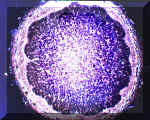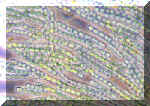ROOTS
Roots are the first organs to emerge
from the seed. 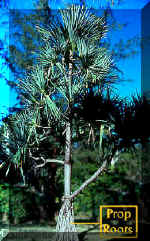 They
penetrate the soil and are responsible for the uptake of water and minerals from the rhizosphere.
Roots contain a tissue called Endodermis. The endodermis is one of the most
important vegetative adaptations of terrestrial plants because it asserts
biological control over water and mineral uptake in the root.
They
penetrate the soil and are responsible for the uptake of water and minerals from the rhizosphere.
Roots contain a tissue called Endodermis. The endodermis is one of the most
important vegetative adaptations of terrestrial plants because it asserts
biological control over water and mineral uptake in the root.
Roots form symbiotic associations with
soil microbes. Virtually all plants have root symbioses. The most famous symbioses
are those that involve nitrogen-fixing microorganisms. However, mycorrhizal
associations between plants and fungi are more universal and
consequently more important in the biosphere.
Roots are the Rodney Dangerfields of
the plant world because they are subterranean for the most part. Out of sight …
However, the root system may be as great as or greater than the shoot
system in terms of biomass and complexity. This is especially true for
the roots of desert plants. I am somewhat prejudiced because I studied strange Cycad roots
for my Ph. D.
The roots of epiphytes are exposed
directly to the atmosphere and have special adaptations to accommodate the consequent
environmental insults that accrue from this. Prop roots help certain plants like Pandanus
to remain erect. Because the prop roots of Pandanus originate from the stem
(not from pre-existing roots) they are called Adventitious. Many vines
produce adventitious roots which help them adhere to their substrate. Ie' Ie
(Freycinetia arborea) is an excellent example of this. Its stem
produces strong adventitious roots which encircle tree trunks, and allow the vine
to grow to the top of the canopy where it can intercept maximal levels of light
for photosynthesis. These roots are extremely fibrous and strong.
Cell walls in the roots are heavily lignified. This makes them resistant to
decay and mechanical damage.
Ancient Hawaiians learned how to use
these roots for fish traps and in house construction. It is a mystery how they got
the roots to be so straight. I have some ideas about this and I think this would
be a good undergraduate research project.
Apical Meristem Organization.
Study demonstration slides of Musa
(banana), Sorbralia, Salix (willow), Cattleya (orchid),
and Epidendrum (orchid).
Trace the files of differentiated cells
Longitudinal
Section of Musa (banana) Root: Identify the major regions.
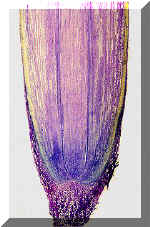
|
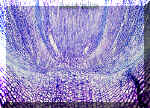
Interface of the Root Cap and Root Body of Banana: Note the
convergence of cells towards one focal point in the Root Body. See the BOX in the lower
image. What term is applied to the cells at this focal point?
Cells in the Root Cap do not converge on the same area as cells in the body. The Root Cap
Meristem (Calyptrogen) is clearly separate from the body and is spread over a wide area.
What type of root organization is this?

Isolated view of the interface between the Root Cap and
Root Body. I added the black line which separates the two regions. Why did I do this? |
It is not important for you
to see the identical number of initial cells indicated below. The most
important distinction is that between open and closed
apex organization & whether there are only a few, or many Initials. Do
not sweat the details!!!!!
In Salix
three groups of "initials" are also present, one giving rise to the central
cylinder, one to the cortex, and one to the epidermis and root cap.
The distinction between the latter two groups is not especially clear.
The organization of the apical meristem
in the two
orchids is
different from those above.
There are apparently two groups of initials,
one giving rise to the central cylinder, and the other to the rest of the tissues.
Which meristems
have the "open" type of organization, and which are "closed"?
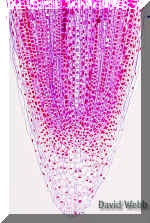
Root Tip of Hyacinth: Note the Convergence of cell Files towards
the Apex |

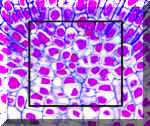
Can you find a distinct Calyptrogen? Is this Open or Closed
organization? |
Last but not least a Cycad Root Tip!
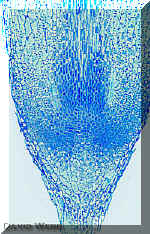
Does it have an Open or Closed Organization? |

Follow the Lines which overlap cell files that pass through the Meristem
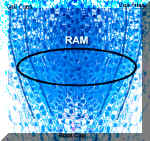
|
Root Tip.
Observe whole mounts of grass seedlings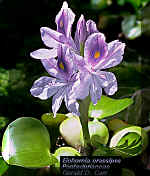
Note especially the root cap, the apical meristem,
and the development of root hairs.
Be careful with these slides. The mounts are very thick
and can be broken easily if you use high magnification objectives.
Examine the intact root systems of Water Hyacinth
(Eichhornia crassipes) or Water Lettuce (Pestia stratiotes) & compare
with the grass seedling.
Can it be easily removed with forceps?
Does this suggest its apical organization (Open vs Closed)?
Water
Hyacinth is one of the worst pest plants in tropical fresh water environments. It grows
like wildfire and crowds out other aquatic species. Its decaying biomass causes
eutrophication. The net result is paradise for the water hyacinth but perdition for all
other plants and associated biota. Evidently, Lake Wilson can have large water hyacinth
blooms from time to time.
Root of an Herbaceous Dicot
The classic example of such a root
is found in the genus 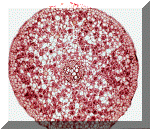 Ranunculus
(buttercup).
Ranunculus
(buttercup).
Identify
whether the developmental
sequence for the xylem is
centrifugal (endarch) or
centripetal (exarch)?
Locate
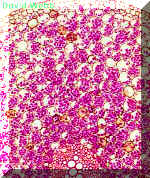 The
following details should be observed as you scan the tissues from the
outside (epidermis) to the center (xylem).
The
following details should be observed as you scan the tissues from the
outside (epidermis) to the center (xylem).
The epidermis may be present or
absent, because it is often poorly preserved, especially in older stages.
In some cases you will be able to see a Casparian
strip in the outermost layer of the cortex, just beneath the epidermis. This is
an Exodermis (or hypodermis). What is its function?
A wide cortex, the cells of which
usually contain starch.
Endodermis with Casparian strips in younger
roots with thick secondary walls and passage cells in older roots.
Single layer of thin-walled pericycle
cells.
The primary xylem. The term primary
means all of the xylem, which develops directly from the procambium.
The strands of primary phloem alternate
with the primary xylem ridges.
What type of archy do you see? di -
tri - tet - pent - poly?
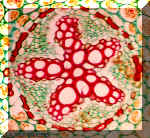
|
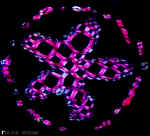
|
Vascular Cylinder of Ranunculus Root: The Endodermis has stained
positively for Lignin. |
Vascular Cylinder of Ranunculus Root seen with crossed polarizers:
The Endodermis and the Xylem are birefringent! |
Root of a Monocot
Smilax
(cat's brier) is a vine and these may be aerial roots. Thus 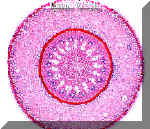 some details of their
anatomy, especially regarding the epidermis and hypodermis may be due to their aerial
environment.
some details of their
anatomy, especially regarding the epidermis and hypodermis may be due to their aerial
environment.
The following details should be noted.
Uniseriate epidermis with
relatively thick walls.
Exodermis beneath the epidermis. Cortex
Most of the cortex consists of starch-containing parenchyma cells, with numerous intercellular
spaces.
The inner layer of the cortex is the endodermis,
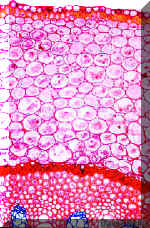 the
cells of which are in the tertiary state of development and exhibit thick secondary
walls which cover the primary radial and inner tangential walls.
the
cells of which are in the tertiary state of development and exhibit thick secondary
walls which cover the primary radial and inner tangential walls.
A thick-walled pericycle, two to six
cells in depth.
A ???????arch vascular cylinder with
20 or more separate strands of primary xylem alternating with an equal number of phloem
strands. The xylem strands are embedded in thick-walled parenchyma similar to that
constituting the pericycle. In each xylem strand the smallest, oldest tracheary elements
occur next to the pericycle. These elements constitute the protoxylem. The
intermediate and large tracheary cells constitute the metaxylem. Similarly, the smallest
sieve elements 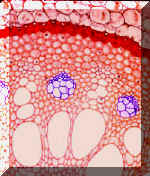 next
to the pericycle, compose the protophloem, the larger sieve elements located
farther inward make up the metaphloem. This means that they have exarch or endarch
maturation. Choose one *arch.
next
to the pericycle, compose the protophloem, the larger sieve elements located
farther inward make up the metaphloem. This means that they have exarch or endarch
maturation. Choose one *arch.
The center of the root contains parenchyma
which have developed thick secondary walls. This area is often called the pith.
However, these cells arise from the procambium and are part of the xylem.
In the case of stem pith, the
parenchyma cells originate from the Ground Meristem. Big deal you might say! In corn
(monocot) a large vessel member occupies the center. This clearly
demonstrates the origin of these cells from the procambium.
Casparian Strip:
 pink-stained Casparian strip as a narrow band in the upper and lower
transverse walls of the endodermis. The Casparian
Strip is one of the most important adaptations of land plants because it brings the
flow of water and solute under biological control!
pink-stained Casparian strip as a narrow band in the upper and lower
transverse walls of the endodermis. The Casparian
Strip is one of the most important adaptations of land plants because it brings the
flow of water and solute under biological control!
 Origin of Branch Roots
Origin of Branch Roots
Examine cross sections of Salix
(willow) roots.

The branch roots originate in the pericycle.
In these slides the branch roots are so large that it may not be evident they originated
from this layer, although their origin is clearly endogenous (from within).
Roots of Water Hyacinth (Eichornia
crassipes)
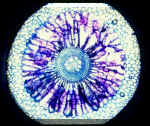 This is a beautiful
plant but it is also a dangerous pest. It thrives in tropical freshwater and
brackish environments. It literally swamps out competitors by growing so rapidly that its
decaying biomass makes the environment anaerobic so that most other species die. It s a
major problem in Florida many tropical countries.
This is a beautiful
plant but it is also a dangerous pest. It thrives in tropical freshwater and
brackish environments. It literally swamps out competitors by growing so rapidly that its
decaying biomass makes the environment anaerobic so that most other species die. It s a
major problem in Florida many tropical countries.

Make transverse sections
Epidermis
- Are root hairs visible???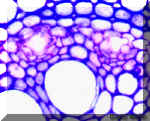
Cortex
Endodermis
Pericycle
Protoxylem
- Metaxylem (Diarch ...?)
Primary
Phloem
Pith
?????
Is
this a Monocot or a Dicot?
Special
Features ?
Where do the hairs originate?
What are the hairs?
Roots of Freycinetia arborea (ie’
ie’)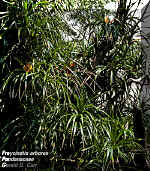
This is a vine-like epiphyte. It grows on
large trees in the forest. It has subterranean roots but it also produces aerial roots,
which attach it to tree trunks and branches. The roots are very strong and resist decay.
They were used by ancient Hawaiians to make fish traps, baskets and cordage. They were
also used as the foundation of feather helmets (manhole).
Study transverse sections
Do
not place your thumb directly 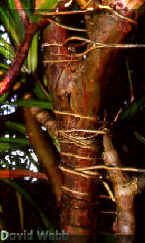 behind the path of the razor blade!!!!!!!
behind the path of the razor blade!!!!!!!
Stain
with Phloroglucinol &
Toluidine Blue.
Examine
Is this a monocot or a dicot????
What are its **archs?
Where are the strengthening cells located?
What tissue or cell type accounts for the
strength of these roots?
these roots?
Why would they resist decay??? Hint
Hint Stain Stain
Root Symbioses
The roots of most plants have
symbiotic relationships with soil microbes. Some of these are unspecialized but others are
extremely refined and involve the differentiation of elaborate root modifications. We will
examine a few cases in this lab.
Legume-Rhizobium
Symbiosis
Roots of many legumes develop symbiotic
relationships with species of the bacterium Rhizobium. The bacteria fix nitrogen
from the atmosphere which becomes available to the legume. There are two kinds of nodules.
Indeterminate nodules
have apical meristems and grow for months. These tend to be cylindrical with
a slightly pointed apex.
Determinate nodules
have a short growth period and live for a few days. These tend to be globular.
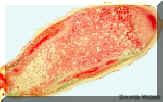
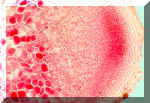
Cycad - Nostoc Symbiosis 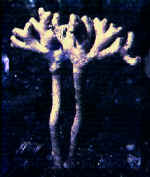
Cycads produce upwardly growing tumescent
roots. These can be inhabited by nitrogen-fixing cyanobacteria
(bluegreen algae). The bacteria trigger an unusual kind of mitosis which results in
programmed cell death. Cell lysis produces a nice home for the cyanobacteria. This is
called the "algal" zone. The bacteria are protected from desiccation, and
they get "free" carbohydrates as well. The Cycad gets nitrogen which is usually
the most limiting essential element in the environment.
Examine
Study

 They
penetrate the soil and are responsible for the uptake of water and minerals from the rhizosphere.
Roots contain a tissue called Endodermis. The endodermis is one of the most
important vegetative adaptations of terrestrial plants because it asserts
biological control over water and mineral uptake in the root.
They
penetrate the soil and are responsible for the uptake of water and minerals from the rhizosphere.
Roots contain a tissue called Endodermis. The endodermis is one of the most
important vegetative adaptations of terrestrial plants because it asserts
biological control over water and mineral uptake in the root. 













 some details of their
anatomy, especially regarding the epidermis and hypodermis may be due to their aerial
environment.
some details of their
anatomy, especially regarding the epidermis and hypodermis may be due to their aerial
environment.


 pink-stained Casparian strip as a narrow band in the upper and lower
transverse walls of the endodermis. The Casparian
Strip is one of the most important adaptations of land plants because it brings the
flow of water and solute under biological control!
pink-stained Casparian strip as a narrow band in the upper and lower
transverse walls of the endodermis. The Casparian
Strip is one of the most important adaptations of land plants because it brings the
flow of water and solute under biological control!










